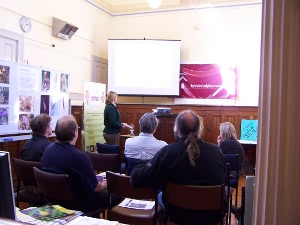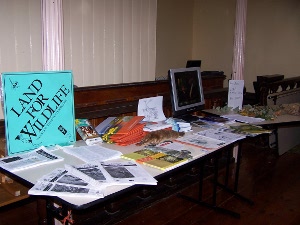The Land for Wildlife program and planting your garden to create habitat for birds
Biography

Kylie Dixon's Land for Wildlife talk
Kylie Dixon, Biodiversity Officer
Department of Sustainability and Environment, Ballarat
I have completed a Bachelor of Natural Resource Management at the University of Melbourne.
Whilst studying a held many job including a position within native plant production at a whole sale nursery that is dedicated to indigenous flora. Working within the nursery I developed excellent skills in plant identification and propagation.
After finishing my degree I gained a position with the Department of Sustainability and Environment on the South West Graduate Program. This took me to Horsham where I started out as a Biodiversity Officer. The majority of my work consisted of providing landholders across the Wimmera with Property Enhancement Grants and developing management plans to assist in the preservation of remnant native vegetation and revegetation.
I then moved on to Daylesford as a Forest Officer were I engaged in forest planning, fire operations, wood utilisation, recreation and pest plants works.
My third placement on the graduate program was in the department’s Geelong office as an Environmental Planner. Here I created standard conditions and letters for planning application responses as well as responding to planning referrals myself.
I have also worked as an Environmental Planner and Biodiversity Office out of Colac and Warrnambool.
I am currently working out of the department’s Ballarat office as a Biodiversity Officer. My roles include native vegetation management, Land for Wildlife, statutory planning, threatened species management, fire fighting and wildlife utilisation.

Interacive displays and handouts
Information from the talk
Favourite websites
- Department of Sustainability and Environment
- Department of Primary Industry
- Greening Australia
- Trust for Nature
- Parks Victoria
- Bird Observation and Conservation Australia
- Birds Australia
- SWIFFT
Favourite books
Costermans, L. F. (Leon F.), Native trees and shrubs of south-eastern Australia. Rigby, Adelaide 1981
Native Trees and Shrubs of South-Eastern Australia embraces an area that stretches from the Flinders and Mt Lofty Ranges in South Australia, across Victoria and southern New South Wales to the NSW South Coast. It records the land and its vegetation in a scientifically accurate, but accessible, style. Virtually all species of native trees and larger shrubs in this area are described, and their occurrences are related to the features of their environments-events of the past, geology, landforms, soil, and climatic conditions. In a systematic sequence, every species is illustrated and accompanied by a distribution map. Descriptive information is concise, and carefully researched.
Richardson, F. J. Richardson, R. G. and Shepherd R. C. Weeds of the south east: an identification guide for Australia. R.G. and F.J. Richardson, 2006
A comprehensive identification guide for weeds in the south-east region of Australia. Includes over 2000 plant species, subspecies, varieties and hybrids including weeds of agriculture, bushland, waterways, gardens, roadsides, wasteland and amenity areas, and many new and emerging problem species. Illustrated with over 1600 photographs including spectacular close-up shots of many features; and situations where the species are likely to be found. Written in easy-to-understand language and beautifully illustrated, this is a field guide for anyone interested in the identification of pest plants and the preservation of our native flora.
Marriott, Neil and Marriott, Jane. Grassland Plants of South-Eastern Australia: A Field Guide. Bloomings Books, 1998
Field guide to the grasslands and grassy woodlands flora of south east Australia, including Tasmania. Provides a general introduction to the history and ecology of grasslands and grassy woodlands as well as describing 170 species and giving information about their distribution and conservation status. Each description is accompanied by a colour photograph. Plants are listed alphabetically by their scientific names, and common names and plant families are given also. Includes a common name index.
Allen, Gerald R. Midgley, Stephen Hamar and Allen, Mark Field guide to the freshwater fishes of Australia. Western Australian Museum, 2002
From tiny gobies to the giant barramundi, this comprehensive volume provides in-depth coverage of nearly 300 species - every fish known to inhabit freshwater on the Australian continent. Stunning illustrations in full colour, with additional hints for rapid identification, complement the concise summary of biological knowledge. Each species has a color image, distribution map, details on general features and identification as well as habitat and status information. The book is divided into three major family sections: families containing species that are primarily confined to fresh waters or at least are dependent on fresh water for part of the life cycle; secondly, the families containing species that are basically marine or estuarine, but are sometimes found in fresh water; and last, the families containing introduced species. The families in each of the three sections are arranged following the natural (phylogenetic) evolutionary order.
Strahan, Ronald and Van Dyck, Steve Mammals of Australia: Third Edition. New Holland Publishing Australia Pty Ltd, 2006
The result of many years of intensive research, The Mammals of Australia has been written by more than 240 authors, all acknowledged experts who have worked in the field with the species they describe. Written in an accessible style, the book provides an account of every species of native mammal known to have existed in Australia since European Settlement; 389 in total. Beautifully illustrated with full-colour photographs, each species account includes a detailed description of the animal and its behaviour, a distribution map and a facts box that gives size, identification features, synonyms and alternative common names, subspecies, conservation status and abundance.
